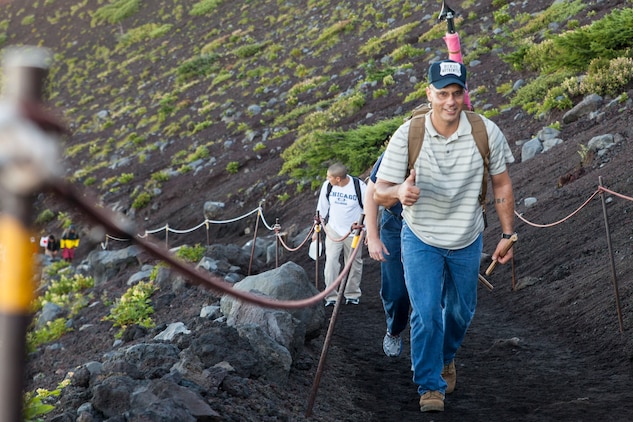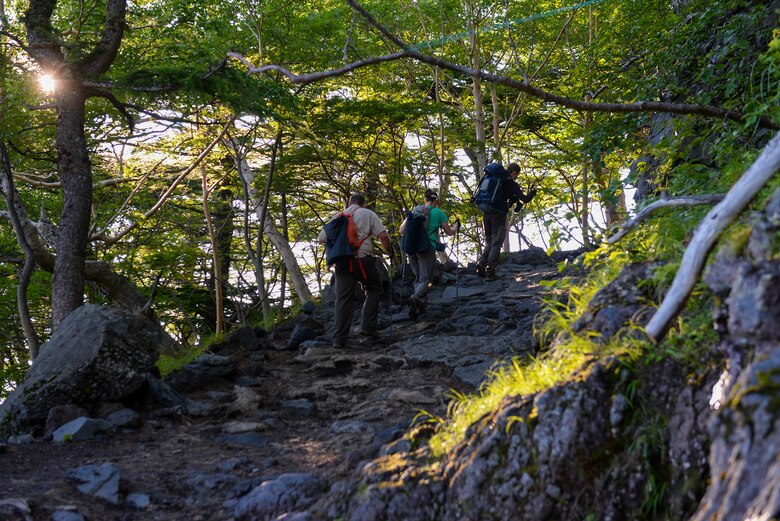Mount Fuji (富士山 Fujisan) located on Honshū, is the highest mountain in Japan at 3,776.24 m (12,389 ft), 2nd-highest peak of an island (volcanic) in Asia, and 7th-highest peak of an island in the world. It is a dormantstratovolcano that last erupted in 1707–1708. Mount Fuji lies about 100 kilometers (60 mi) south-west of Tokyo, and can be seen from there on a clear day. Mount Fuji's exceptionally symmetrical cone, which is snow-capped for about 5 months a year, is a well-known symbol of Japan and it is frequently depicted in art and photographs, as well as visited by sightseers and climbers.

Mount Fuji is one of Japan's "Three Holy Mountains" along with Mount Tate and Mount Haku. It is also a Special Place of Scenic Beauty and one of Japan's Historic Sites.It was added to the World Heritage List as a Cultural Site on June 22, 2013. According to UNESCO, Mount Fuji has "inspired artists and poets and been the object of pilgrimage for centuries". UNESCO recognizes 25 sites of cultural interest within the Mount Fuji locality. These 25 locations include the mountain and the Shinto shrine, Fujisan Hongū Sengen Taisha, as well as the Buddhist Taisekiji Head Temple founded in 1290, later immortalized by Japanese ukiyo-e artist Katsushika Hokusai.
Mount Fuji is an attractive volcanic cone and a frequent subject of Japanese art especially after 1600, when Edo (now Tokyo) became the capital and people saw the mountain while traveling on the Tōkaidō road. The mountain is mentioned in Japanese literature throughout the ages and is the subject of many poems.One of the modern artists who depicted Fuji in almost all her works was Tamako Kataoka.
It is thought that the first recorded ascent was in 663 by an anonymous monk.The summit has been thought of as sacred since ancient times and was forbidden to women until the Meiji Era in the late 1860s. Ancient samurai used the base of the mountain as a remote training area, near the present-day town of Gotemba. The shōgun Minamoto no Yoritomo held yabusame in the area in the early Kamakura period.Founded by Nikko Shonin in 1290 on the lower slopes of Mount Fuji in Shizuoka Prefecture is the Taiseki-ji temple complex, the central base headquarters of Nichiren Shōshū Buddhism, which is visited by thousands of westerners and Asian believers from neighbouring countries each year who go on varying Tozan pilgrimages.

The first ascent by a foreigner was by Sir Rutherford Alcock in September 1868, from the foot of the mountain to the top in eight hours and three hours for the descent. Alcock's brief narrative in The Capital of the Tycoon was the first widely disseminated description of the mountain in the West. Lady Fanny Parkes, the wife of British ambassador Sir Harry Parkes, was the first non-Japanese woman to ascend Mount Fuji in 1869. Photographer Felix Beato climbed Mount Fuji in the same year.On March 5, 1966, BOAC Flight 911, a Boeing 707, broke up in flight and crashed near the Mount Fuji Gotemba New fifth station, shortly after departure from Tokyo International Airport. All 113 passengers and 11 crew members died in the disaster, which was attributed to extreme clear air turbulence caused by lee waves downwind of the mountain. There is a memorial for the crash a short distance down from the Gotemba New fifth station.
Today, Mount Fuji is an international destination for tourism and mountain climbing.In the early 20th century, populist educator Frederick Starr's Chautauqua lectures about his several ascents of Mount Fuji—1913, 1919, and 1923—were widely known in America. A well-known Japanese saying suggests that a wise person will climb Mt. Fuji once in their lifetime, but only a fool would climb it twice.It remains a popular symbol in Japanese culture, including making numerous movie appearances,inspiring the Infiniti logo,and even appearing in medicine with the Mount Fuji sign. In September 2004, the manned weather station at the summit was closed after 72 years in operation. Observers monitored radar sweeps that detected typhoons and heavy rains. The station, which was the highest in Japan at 3,780 metres (12,402 ft), was replaced by a fully automated meteorological system.As of 2011, the Japan Self-Defense Forces and the United States Marine Corps continue to operate military bases near Mount Fuji.
Mount Fuji was added to the World Heritage List as a Cultural Site on June 22, 2013. However, the inscription became controversial after two professors at the Mt. Fuji World Heritage Centre, Shizuoka, were forced to quit their jobs due to academic and racial harassment by officials of Shizuoka prefecture government in March 2018 and comments on social media called for the cancellation of Mt. Fuji's World Heritage inscription.

Mount Fuji is a very distinctive feature of the geography of Japan. It stands 3,776.24 m (12,389 ft) tall and is located near the Pacific coast of central Honshu, just west of Tokyo. It straddles the boundary of Shizuoka and Yamanashi Prefectures. Four small cities surround it: Gotemba to the east, Fujiyoshida to the north, Fujinomiya to the southwest, and Fuji to the south. It is also surrounded by five lakes: Lake Kawaguchi, Lake Yamanaka, Lake Sai, Lake Motosu and Lake Shōji. They, and nearby Lake Ashi, provide views of the mountain. The mountain is part of the Fuji-Hakone-Izu National Park. It can be seen more distantly from Yokohama, Tokyo, and sometimes as far as Chiba, Saitama, Tochigi, Ibaraki and Lake Hamana when the sky is clear. Particularly in the winter it can be seen from the Shinkansen until it reaches Utsunomiya station. It has also been photographed from space during a space shuttle mission (see image, below).
Mount Fuji is located at a trench-trench-trench triple junction where the Amurian Plate (Eurasian Plate), the Okhotsk Plate(North American Plate), and the Philippine Sea Plate meet.These three plates form the western part of Japan, the eastern part of Japan, and the Izu Peninsula respectively.The Pacific Plate is being subducted beneath these plates, resulting in volcanic activity. Mount Fuji is also located near three island arcs: the Southwestern Japan Arc, the Northeastern Japan Arc, and the Izu-Bonin-Mariana Arc.
Mt. Fuji's main crater is 780 m in diameter and 240 m in depth. The bottom of the crater is 100–130 m in diameter. Slopeangles from the crater to a distance of 1.5–2 km are 31°–35°, the angle of repose for dry gravel. Beyond this distance, slope angles are about 27°, due to the presence of scoria. Mid-flank slope angles decrease from 23° to less than 10° in the piedmont. Scientists have identified four distinct phases of volcanic activity in the formation of Mount Fuji. The first phase, called Sen-komitake, is composed of an andesite core recently discovered deep within the mountain. Sen-komitake was followed by the "Komitake Fuji", a basaltlayer believed to be formed several hundred thousand years ago. Approximately 100,000 years ago, "Old Fuji" was formed over the top of Komitake Fuji. The modern, "New Fuji" is believed to have formed over the top of Old Fuji around 10,000 years ago.

Pre-Komitake started erupting in the Middle Pleistocene in an area 7 km north of Mount Fuji. After a relatively short pause, eruptions began again which formed Komitake Volcano in the same location. These eruptions ended 100,000 years ago. Ashitake Volcano was active from 400,000 to 100,000 years ago, and is located 20 km southeast of Mount Fuji. Mount Fuji started erupting 100,000 years ago, with Ko-Fuji (old-Fuji) forming 100,000 to 17,000 years ago, but which is now almost completely buried. A large landslide on the southwest flank occurred about 18,000 years ago. Shin-Fuji (new-Fuji) eruptions in the form of lava, lapilli and volcanic ash, have occurred between 17,000 and 8,000 years ago, between 7,000 and 3,500 years ago, and between 4,000 and 2,000 years ago. Flank eruptions, mostly in the form of parasitic cinder cones, ceased in 1707. The largest cone, Omuro-Yama, is one of more than 100 cones aligned NW-SE and NE-SW through the summit. Mt. Fuji also has more than 70 lava tunnels and extensive lava tree molds. Two large landslides are at the head of the Yoshida-Osawa and Osawa-Kuzure valleys.
As of December 2002, the volcano is classified as active with a low risk of eruption. The last recorded eruption was the Hōei eruption which started on December 16, 1707 (Hōei 4, 23rd day of the 11th month), and ended about January 1, 1708 (Hōei 4, 9th day of the 12th month), during the Edo period.The eruption formed a new crater and a second peak, named Mount Hōei (after the Hōei era), halfway down its southeastern side. Fuji spewed cinders and ash which fell like rain in Izu, Kai, Sagami, and Musashi.Since then, there have been no signs of an eruption. In the evening of March 15, 2011, there was a magnitude 6.2 earthquake at shallow depth a few kilometres from Mount Fuji on its southern side. But according to the Japanese Meteorological Service there was no sign of any eruption.

Comments
Post a Comment